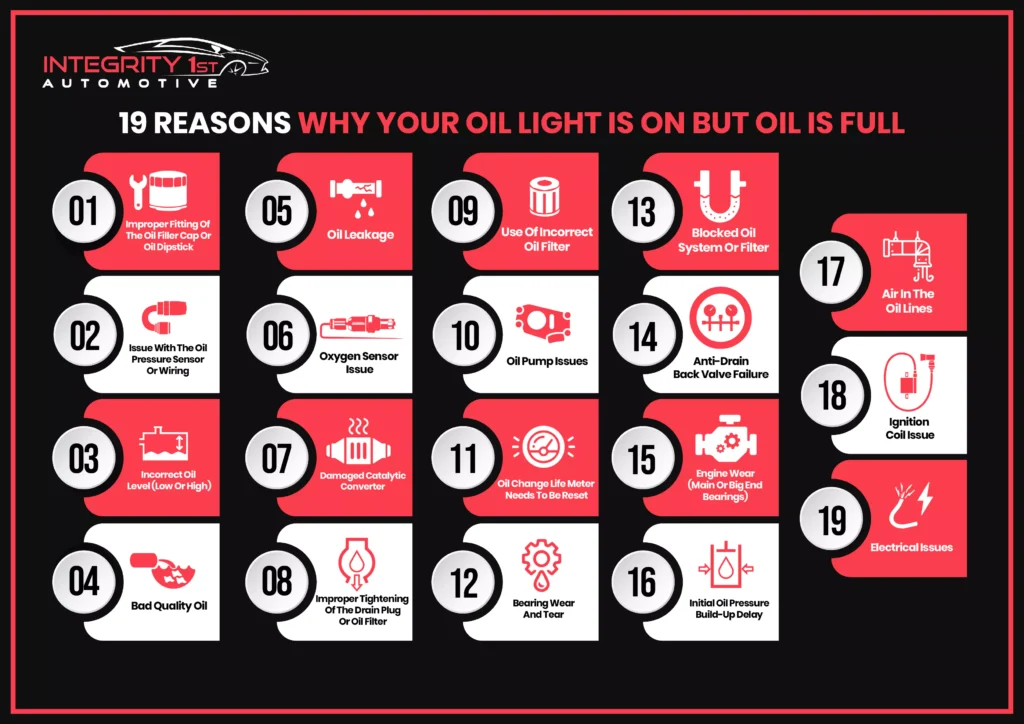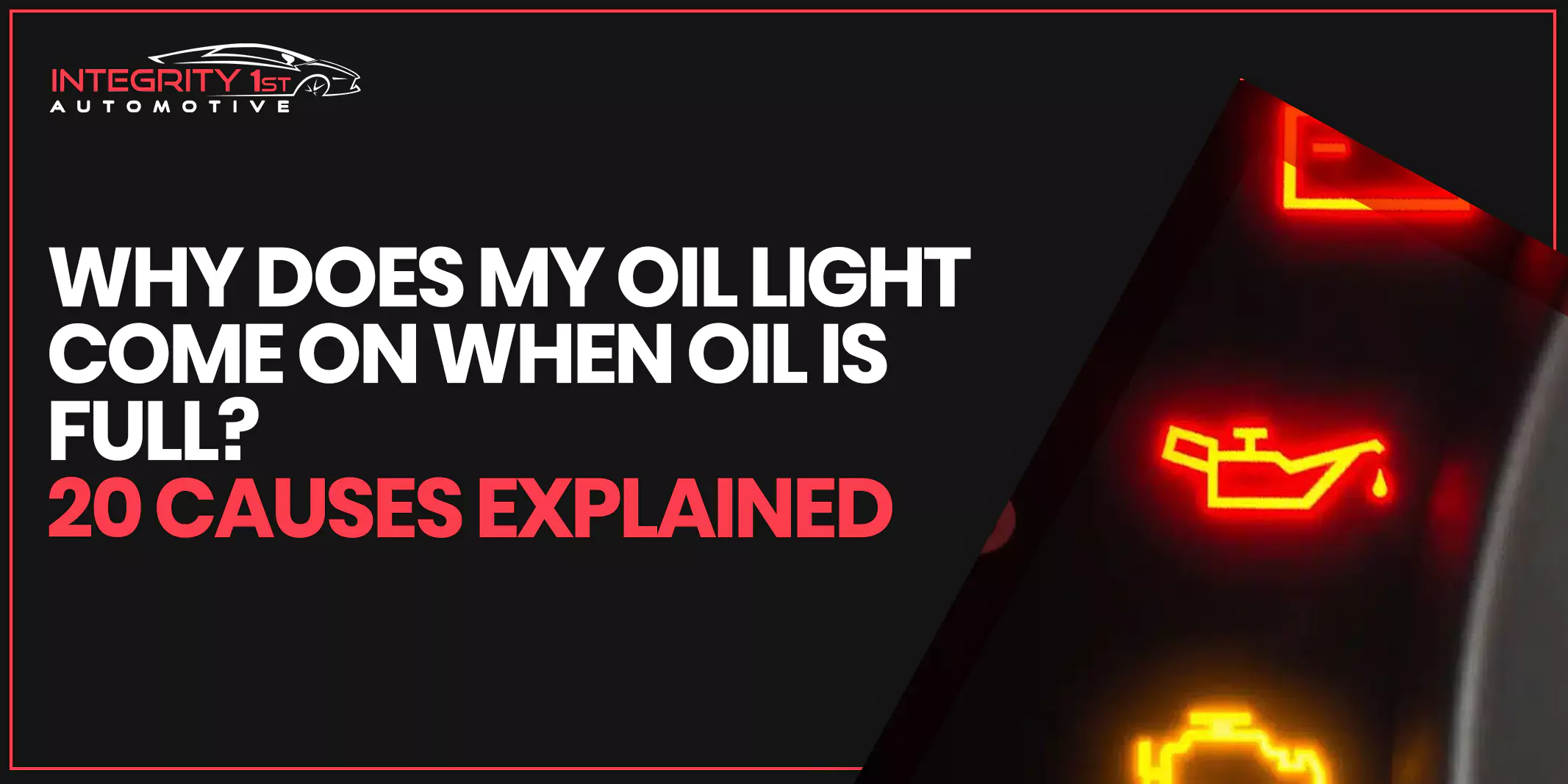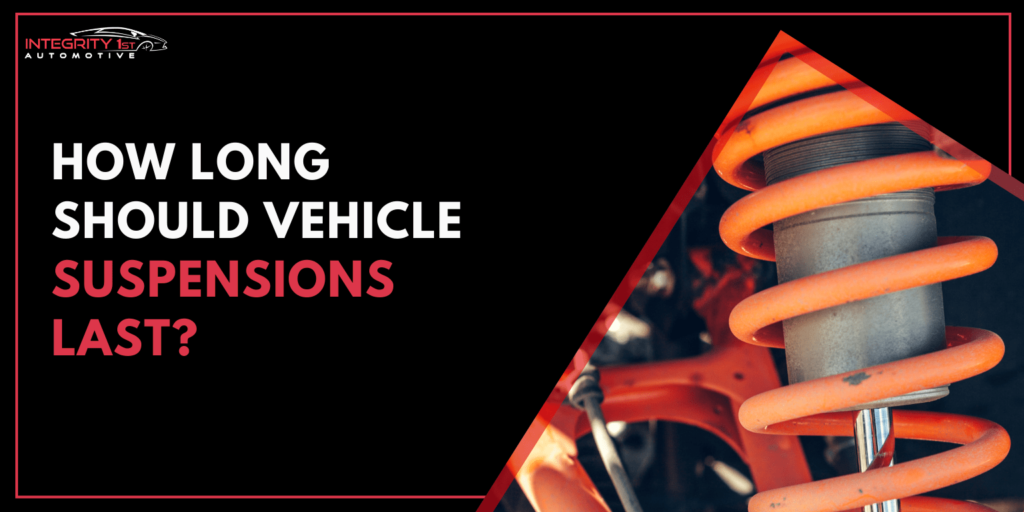The sudden illumination of your vehicle’s oil light is a source of panic and can be due to many reasons, including low oil pressure and oil levels in the tank. But what if your dipstick reveals a perfectly acceptable oil level?
One of the common questions we get is, “Why does my oil light come on, but the oil is full?”
Imagine the shock of your oil light flashing, only to find your car’s oil levels topped up! This situation may leave the driver confused and concerned about potential engine damage.
In this article, we’ll explore the possible culprits behind this annoying problem and discover solutions to safely get your car back on the road.
Stay with us!
Oil Light Comes On But Oil is Full: What To Do?
If upon checking your oil level, you find no issues, the first question that pops into your mind is; “why is my oil light flashing?”
Now, your first instinct may be to ignore the warning, but it’s highly dangerous. The engine oil pressure warning light can indicate several major issues with your engine that require immediate attention.
The first step you can do is to identify the root cause of this problem. You can diagnose this problem or consult an auto repair shop near you for a proper diagnosis.
Some of the common factors that could be responsible for your blinking oil light include:
- Clogged oil filter
- Faulty oil pressure sensor
- Issues with your oil pump
Whatever the case may be, it’s important to have your vehicle diagnosed by a qualified technician to investigate the root cause.
Always avoid driving with an illuminated oil light to protect your engine from potential damage.
Reasons Why Your Oil Light is On But Oil Is Full
The oil light indicator can be a serious issue that may cause unnecessary expenses and frustration. It is best to consult a professional mechanic to diagnose the actual problem.
However, there are a few factors that can cause this issue.

Improper Fitting of the Oil Filler Cap or Oil Dipstick
Sometimes, trivial issues, such as improper fitting of the oil filler cap can disturb everything, even oil level readings. As a result, your oil light is illuminated.
To make sure everything goes perfectly, ensure the oil filler cap or oil dipstick is securely in place.
Issue with the Oil Pressure Sensor or Wiring
If there’s a fault in your oil pressure sensor or wiring, it can send inaccurate signals to the ECU, causing the light to blink.
Check your sensor and wiring issues weekly to avoid this problem.
Incorrect Oil Level (Low or High)
Sometimes, even when the dipstick indicates a full oil level, the actual level might differ. This is due to improper measurements or many other factors.
To cater to this issue, check the oil level accurately with a flashlight and dipstick to avoid confusion.
Bad Quality Oil
Inferior quality vehicle oil affects the overall performance and properties. Sometimes, your vehicle may also consume more oil than required, signalling the oil light.
It’s always recommended to choose the oil that meets your vehicle’s specifications.
Oil Leakage
Persistent oil leaks in your tank cause the oil level to drop significantly while keeping the reading normal.
To learn more about detecting leaks early, check out how to find an oil leak for helpful tips.
Schedule a monthly appointment with your mechanic to inspect for leaks and address them timely.
Oxygen Sensor Issue
The faulty oxygen sensor is a rare occurrence but it can interfere with the ECU’s calculation to signal an incorrect oil light.
A professional technician will inspect your vehicle and diagnose the solution promptly.
Damaged Catalytic Converter
A damaged catalytic converter affects the engine performance, leading to an illuminated oil light.
Inspect your catalytic converter and contact your expert technician to solve the issue.
Improper Tightening of the Drain Plug or Oil Filter
One of the main causes of oil leaks is the incorrectly tightened drain plugs or oil filters. This affects oil pressure, and as a result, the oil light comes on even if the oil tank is full.
To cater to this, ensure the drain plugs or oil filters are tightened properly during oil changes.
Use of Incorrect Oil Filter
Incompatible oil filters hinder the oil flow and pressure, illuminating your oil light occasionally.
Always ask your mechanic before choosing the oil filters and only use the recommended filters to avoid inconvenience.
Oil Pump Issues
The purpose of an oil pump is to circulate the oil effectively. However, a malfunctioning oil pump cannot do that, leading to low oil pressure that triggers your oil light.
Oil pump issues are best diagnosed and repaired by industry professionals.
Oil Change Life Meter Needs to Be Reset
If you have a vehicle with an oil change life meter, make sure to reset it after every oil change according to the owner’s manual.
Bearing Wear and Tear
Check the main or big end bearing of your engine. Sometimes, minor wear and tear of the bearing can affect oil pressure and trigger the light.
This is a serious problem that requires the immediate attention of a professional mechanic or technician.
Blocked Oil System or Filter
A clogged oil filter restricts the oil flow and results in low oil pressure.
To diagnose this problem, consult with a mechanic for proper inspection and cleaning of the filters.
Anti-Drain Back Valve Failure
If your anti-drain back valve is faulty, it prevents oil from draining back into the oil pan, especially when the engine is off. This affects oil pressure upon startup, leading to delayed oil pressure build-up, triggering the oil light.
To cater to this, replace the valve to restore proper oil circulation.
Engine Wear (Main or Big End Bearings)
Potential wear and tear of the engine in main or big end bearings may cause oil pressure issues, leading to an illuminated oil light even if the oil levels are sufficient.
If the problem occurs, contact a professional mechanic to get it sorted.
Initial Oil Pressure Build-Up Delay
Sometimes, your engine may take a few seconds to build up oil pressure right after startup. As a result, you may notice a brief oil light flicker, which is normal in most cases.
However, if the problem persists, make sure to contact your nearest technician.
Air in the Oil Lines
Just like clogged lines can disrupt the oil flow and pressure, the air in the oil lines can also disturb the oil flow.
This is especially common after a scheduled oil change or engine repair.
To solve this, your mechanic may bleed the air from the system to allow it to function properly.
Ignition Coil Issue
Though uncommon, a faulty ignition coil can affect your engine’s performance and trigger the oil light.
To solve this issue, get your ignition coils checked monthly.
Electrical Issues
Sometimes faulty wiring or ECU malfunctions can disrupt the whole system and can cause the light to flicker incorrectly.
If this happens, contact an expert technician for proper inspection, diagnosis, and repair.
What Should I Do If I Couldn’t Diagnose The Exact Problem
Even though our list of possible reasons for bad oil pressure sensor symptoms covers almost everything, there are a few moments when you’re puzzled by the persistent oil light.
When it happens, know that things are out of your hands and it’s time to seek professional help. Ignoring the flickering light is never an option and leaving it unattended can lead to severe engine damage, leading to costly repairs.
Integrity 1st Auto has a team of skilled technicians who have the expertise to diagnose the root cause of your oil light problem. With our advanced diagnostic equipment, you can now identify the problem and get the solutions within a few hours.
Prevent your vehicle’s engine from damage and costly repairs with our trusted services. Contact us today to schedule an appointment.
At Integrity 1st Auto, our skilled technicians have the expertise to accurately diagnose the root cause of your oil light issue. We utilize advanced diagnostic equipment to pinpoint the problem and recommend appropriate solutions. Don’t risk further damage to your vehicle. Contact us today to schedule an appointment and let our professionals restore your car’s health.
Conclusion
Now you know what to do when the oil light comes on! It’s not ignoring it.
If you notice that your oil light comes on and off but the oil is still full, know that it’s a serious warning that needs to be addressed immediately. Many factors contribute to the illuminated oil light, including sensor malfunctions, engine issues, low oil pressure, etc. Whatever it is, the consequences of ignoring the signs are serious.
Therefore, consulting qualified mechanics can diagnose the issue and provide recommendations based on your needs and requirements. Avoid risking further damage to your vehicle and contact Integrity 1st Auto today for a quote and consultation.
FAQ
Will The Oil Light Reset Itself?
No, the oil light doesn’t reset itself.
Why Does The Oil Light Come On If My Oil Level Is Full?
When the oil light is turned on, it indicates low oil pressure, which doesn’t mean low oil levels. It can be due to low oil pressure.
What Are The Potential Risks Of Ignoring The Oil Light?
The potential risk of ignoring the oil light is severe engine damage, leading to increased repair costs.
How Do You Reset The Light After An Oil Change?
It depends on your vehicle. Consult your owner’s manual for brief instructions.
How Long Does The Oil Light Remain On After An Oil Change?
It’s uncommon for the oil change light to remain on after an oil change. If this happens, there’s an underlying issue that needs proper attention.




